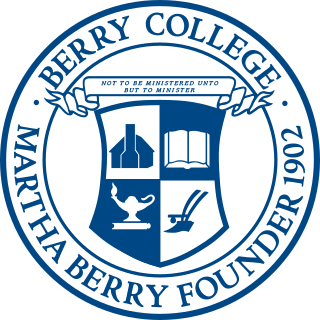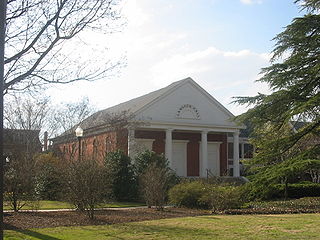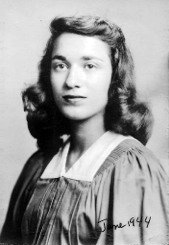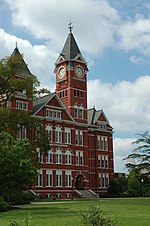
The University of North Carolina at Greensboro is a public research university in Greensboro, North Carolina. It is part of the University of North Carolina system. It is accredited by the Southern Association of Colleges and Schools Commission on Colleges to award baccalaureate, masters, specialist, and doctoral degrees.

Auburn University is a public land-grant research university in Auburn, Alabama, US. With more than 26,800 undergraduate students, over 6,100 post-graduate students, and a total enrollment of more than 33,000 students with 1,330 faculty members, Auburn is the second-largest university in Alabama. It is one of the state's two flagship public universities. The university is classified among "R1: Doctoral Universities – Very High Research Activity".

The University of Alabama is a public research university in Tuscaloosa, Alabama. Established in 1820 and opened to students in 1831, the University of Alabama is the oldest and largest of the public universities in Alabama as well as the University of Alabama System. It is classified among "R1: Doctoral Universities – Very high research activity".

The State University of New York at Albany, commonly referred to as the University at Albany, UAlbany or SUNY Albany, is a public research university with campuses in Albany, Rensselaer, and Guilderland, New York. Founded in 1844, it is one of four "university centers" of the State University of New York (SUNY) system.

Quinnipiac University is a private university in Hamden, Connecticut. The university grants undergraduate, graduate, and professional degrees. It also hosts the Quinnipiac University Polling Institute.

The University of North Alabama (UNA) is a public university in Florence, Alabama. It is the state's oldest public university. Occupying a 130-acre (0.5 km2) campus in a residential section of Florence, UNA is located within a four-city area that also includes Tuscumbia, Sheffield and Muscle Shoals. The four cities compose a metropolitan area with a combined population of 140,000 people.

Hobart and William Smith Colleges are private liberal arts colleges in Geneva, New York. They trace their origins to Geneva Academy established in 1797. Students can choose from 45 majors and 68 minors with degrees in Bachelor of Arts, Bachelor of Science, Master of Arts in Teaching, Master of Science in Management, and Master of Arts in Higher Education Leadership.

South Carolina State University is a public, historically black, land-grant university in Orangeburg, South Carolina. It is the only public, historically black land-grant institution in South Carolina, is a member-school of the Thurgood Marshall College Fund, and is accredited by the Southern Association of Colleges and Schools (SACS).

Tennessee Technological University is a public research university in Cookeville, Tennessee. It was formerly known as Tennessee Polytechnic Institute, and before that as University of Dixie, the name under which it was founded as a private institution. Affiliated with the Tennessee Board of Regents, the university is governed by a board of trustees. It is classified among "R2: Doctoral Universities – High research activity".

Berry College is a private liberal arts college in the Mount Berry community adjacent to Rome, Georgia. It is accredited by the Southern Association of Colleges and Schools (SACS). Berry College was founded on values based on Christian principles in 1902 by Martha Berry.

The University of Alabama in Huntsville (UAH) is a public research university in Huntsville, Alabama. The university is accredited by the Southern Association of Colleges and Schools and comprises nine colleges: arts, humanities & social sciences; business; education; engineering; honors; nursing; professional & continuing studies; science; and graduate. The university's enrollment is approximately 10,000. It is part of the University of Alabama System and is classified among "R1: Doctoral Universities: Very High Research Activity".

The University of Alabama, the state's oldest continuously public university, is a senior comprehensive doctoral-level institution located in Tuscaloosa, Alabama.

Missouri Southern State University is a public university in Joplin, Missouri. It was established in 1937 as Joplin Junior College. The university enrolled 4,346 students in Fall 2021.

Illinois College is a private liberal arts college in Jacksonville, Illinois. It is affiliated with the United Church of Christ and the Presbyterian Church (USA). It was the second college founded in Illinois but the first to grant a degree. It was founded in 1829 by the Yale Band, students from Yale College who traveled westward to found new colleges. It briefly served as the state's first medical school, from 1843 to 1848.

Auburn High School is a public high school in Auburn, Alabama. It is the only high school in the Auburn City School District. Auburn High offers technical, academic, and International Baccalaureate programs, as well as joint enrollment with Southern Union State Community College and Auburn University. Auburn High School is accredited by the Southern Association of Colleges and Schools.

Langdon Hall is a building on the campus of Auburn University in Auburn, Alabama, United States. Built in the Greek Revival style in 1846 as the chapel for the Auburn Female College and moved to the Auburn University campus in 1883, Langdon Hall is the oldest building in the city of Auburn, and today houses an auditorium and office space for Auburn University staff. Before the Civil War, Langdon Hall served as the location for a series of debates on the question of Southern secession, involving William Lowndes Yancey, Alexander Stephens, Benjamin Harvey Hill, and Robert Toombs. Langdon Hall is named for Charles Carter Langdon, a former mayor of Mobile, Alabama, Alabama Secretary of State, and a trustee of Auburn University from 1872–1889.

The Quad is an approximately 22-acre (8.9 ha) quadrangle on the campus of the University of Alabama located in Tuscaloosa, Alabama. Home to most of the university's original buildings, this portion of the campus remains the geographic and historic center of the modern campus. Originally designed by noted English-born architect William Nichols, construction of the university campus began in 1828, following the move of the Alabama state capital from Cahaba to Tuscaloosa in 1826. The overall design for this early version of the campus was patterned after Thomas Jefferson's plan for the University of Virginia, with its Lawn and Rotunda. Following the destruction of the campus during the American Civil War, a new Quad emerged in the late 19th and early 20th centuries. Different in form and function from the original design of the early 19th century, the modern Quad continues to fill its role as the heart of the campus. Although surrounded by academic and administrative buildings, only five structures are built directly on the Quad: the Little Round House, Tuomey Hall, Oliver-Barnard Hall, Amelia Gayle Gorgas Library, and Denny Chimes. The remainder of the space is occupied by a grove of trees on the west side and a great lawn on the east. A feature on the northwestern side, known as The Mound, is the site of the old Franklin Hall. A popular gathering place, the Quad is home to pep rallies, a bonfire during homecoming, and numerous day-to-day student activities.
The Alabama Women's Hall of Fame honors the achievements of women associated with the U.S. state of Alabama. Established in 1970, the first women were inducted the following year. The museum is located in Bean Hall, a former Carnegie Library, on the campus of Judson College in Marion, Alabama. It became a state agency in 1975 by an act of the Alabama Legislature. The organization is governed by an eleven-member board. They are elected to three-year terms with a minimum of one board member from the fields of art, business, community service, education, law, medicine, politics, religion, and science. In addition to the board, the President of Judson College and Governor of Alabama both serve as voting members.

Bernice Resnick Sandler was an American women's rights activist. She is best known for being instrumental in the creation of Title IX, a portion of the Education Amendments of 1972, in conjunction with representatives Edith Green and Patsy Mink and Senator Birch Bayh in the 1970s. She has been called "the Godmother of Title IX" by The New York Times. Sandler wrote extensively about sexual and peer harassment towards women on campus, coining the phrase "the chilly campus climate".

Katharine Cooper Cater was an American academic administrator. She was the Dean of Women at Auburn University from 1946 to 1975 and later became the Dean of Student Life there. Cater was born on September 1, 1914, and died at the age of 65 on July 23, 1980. She was buried in Rosehill Cemetery in Bibb County, Georgia.























